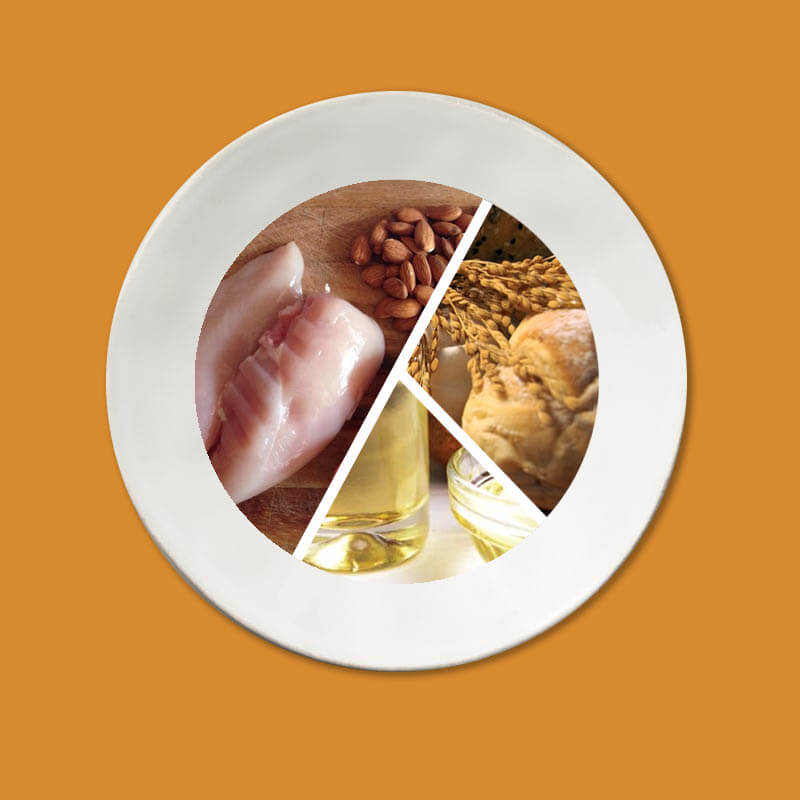It’s easy to underestimate with what a portion looks like. Typically when you eat in a restaurant, an entrée is at least a double portion.
If you started off with an appetizer, visualize the amount of food you just ate prior to your dinner sitting next to your entrée. That should help you calculate how much more you can afford to eat without going overboard. Then add on any bread. Some people make the mistake of eating a full dinner but they’ve already eaten a few slices of bread beforehand and don’t really think that counts. Take note that even though you may have had fish and vegetables for dinner, with the bread included it’s about the equivalent of eating a slice or two of pizza. Probably even worse, since pizza just has sauce and cheese. You are now adding on fish and an entire serving of vegetables that was probably sautéed in oil.
To go back to basics, let’s get clear on how to visualize a portion.
Protein A serving of protein should be around 4-6 ounces. Four ounces is roughly the size of your fist. The next time you’re eating a piece of fish, meat, or poultry, have that in mind. You should be conscious of not eating more than a fist and a half of any of these main foods at a time.
Fats Healthy fats such as olive oil, flax oil, coconut oil or almond butter can be eaten daily but not poured liberally because the fat and calorie content will add up. Each tablespoon is around 100 calories and contains over 10 grams of fat. Without paying attention, you can easily rack up 300-400 calories and 30-40 grams of fat with these oils or butters alone without even calculating the additional ingredients in your meal. Use an actual tablespoon to serve yourself and follow the same guidelines with high-calorie condiments such as mayonnaise, salad dressing or tahini. So although salads and vegetables are healthy, a giant portion will most likely not be eaten raw. Think about how much dressing or oil is required to make an overflowing bowl of kale taste good. Is it 4, 5, 6 tablespoons? Maybe more?
Carbohydrates While you don’t have to be too conscious about the carbohydrates in most vegetables (especially the green leafy ones), healthy starches like rice, quinoa, sweet potato, butternut squash, amaranth and non-gluten containing grains still need to be portioned. A half cup/ one full cup is a serving. Visualize a baseball as one cup and then determine if you should divide that in half.
When eating fruit, stick to whole fruit which is much easier to portion out. Try to avoid loose grapes, chopped watermelon, papaya, mango, etc. (although they have many vitamins and nutrients). It’s very easy to sit in bed watching a movie eating a pound of any of these fruits in a large bowl as if they were popcorn. Without paying attention, you could easily eat a few hundred calories with hefty amounts of fructose and carbohydrates. Having an organic peach, pear, apple or orange (when in season) will prevent you from overeating. To make it last longer you can cut it into small slices and add a few raw nuts to make it more satisfying, yet you’ll know when it’s time to stop. Berries happen to be loose fruits which are the exception, but better not to have them as a standalone snack. A half cup is too small of a serving size to generally be satisfying. Berries are great, though, when combined with yogurt, a smoothie or as a side to your morning omelet.
Knowing your portions allows you to enjoy going out for dinner, being social, going on vacation and never having to worry about getting fat. While there are healthier choices than others, sometimes you want to splurge on food that’s not so ideal. I promise if you cheat every now and then (but are generally portion aware), it won’t ever make a dent in your weight.

